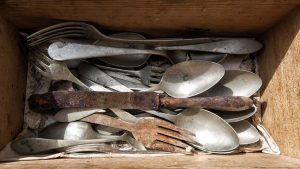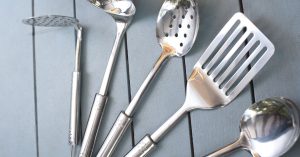Silicone culinary implements play a vital role in domestic gastronomy, encompassing silicone spatulas, silicone baking pans, silicone baking mats, and more.
Let’s elucidate the significance of how to clean silicone kitchen utensils. If the task of cleaning and maintenance is not executed meticulously, certain blemishes, grease, and oil may persist on culinary equipment.
Moreover, this can give rise to the formation of mold and bacteria on the utensils, posing a direct threat to our well-being.
Below, we shall disclose the appropriate procedures for cleansing and maintaining silicone kitchen utensils.
How To Clean Silicone Kitchen Utensils: Silicone kitchenware can be soaked in warm water to loosen dry food particles, facilitating easier scrubbing. It is durable and dishwasher safe, suitable for top rack cleaning.
Quick Navigation
How To Clean Silicone Kitchen Utensils?
Steps to Clean Silicone Kitchen Utensils:
Revitalize Your Utensils with a Soothing Soak:
Immerse Your Affected Utensils in Hydrogen Peroxide for a 24-Hour Soak

First-Use and Premier Cleaning for Silicone Kitchen Utensils:
- When you receive new silicone kitchen utensils, it’s important to give them a thorough cleaning.
- Use warm water and dish soap to wash away any dirt or dust from the silicone utensils.
- To sterilize the silicone kitchenware, you can boil them in water. Be cautious not to let the silicone touch the bottom of the pot, as extreme temperatures can damage the material.
- Alternatively, you can sterilize silicone utensils in a disinfection unit, baking oven, or microwave. Just ensure that the container’s temperature doesn’t exceed 240℃, and avoid letting the silicone become too dry in the oven by adding a small amount of water for protection.
- A sterilization time of 10 to 30 minutes is sufficient.
- After the premier cleaning and sterilization, hang up the silicone kitchen utensils and allow them to air dry. Keeping them dry helps prevent the formation of mold and bacteria on the surface.
- When using silicone kitchen utensils for the first time, remember to clean them with water to remove any surface dust or debris before use.
Post-Use Maintenance: Ensure the Cleanliness of Silicone Kitchen Utensils
Cleaning Guidelines for Used Silicone Kitchen Utensils:
- After utilizing silicone kitchen utensils such as muffin pans and baking mats, remove any leftover cooked food. To facilitate easy removal of dry residue, we recommend immersing the silicone kitchenware in warm water.
- Silicone is known for its durability and dishwasher-safe nature. For regular washing, simply place the utensils on the top rack of the dishwasher.
- When opting for manual cleaning, prepare hot water, dish soap specifically designed to combat grease, and a gentle sponge or brush. This method effectively removes grease and food residues while protecting the kitchenware’s surface.
- Note that high-quality silicone kitchen utensils feature a smooth surface treatment, eliminating the need for anti-stick oil. Be cautious when scrubbing or brushing to avoid damaging the smooth surface.
- Stubborn stains can be softened by submerging kitchenware in boiling water, making them easier to brush away.
- Baking soda serves as an excellent scrubbing agent, while toothpaste can also be used as an effective cleaning tool.
Maintaining Silicone Utensils
Silicone utensils are versatile and durable tools for your kitchen. To ensure their longevity and optimal performance, follow these guidelines for maintaining and caring for your silicone utensils:
- Gentle Cleaning: After each use, clean the silicone utensils using warm water and mild dish soap. This will help remove any food residues and keep them free from stains or odors.
- Avoid Abrasive Cleaners: When cleaning silicone utensils, avoid using abrasive cleaners or harsh scrubbing tools, as they can damage the silicone surface. Opt for soft sponges or non-abrasive brushes instead.
- Dishwasher Safe: Most silicone utensils are dishwasher safe. Place them on the top rack of your dishwasher for easy and convenient cleaning.
However, if the utensils have wooden or other non-silicone components, it’s best to wash them by hand to prevent damage.
- Heat Resistance: Silicone utensils are heat resistant, but it’s important to avoid exposing them to direct flame or extreme heat. This can cause the silicone to melt or become damaged. Always use silicone utensils within their recommended temperature range.
- Stain Removal: If your silicone utensils develop stubborn stains, you can try soaking them in a solution of equal parts white vinegar and water. Let them soak for a few minutes before gently scrubbing away the stains. Rinse thoroughly afterward.
- Storage: Store your silicone utensils in a clean and dry utensil holder or drawer. Avoid stacking them tightly to prevent deformation or sticking together. If possible, hang them or keep them separate to maintain their shape.
By following these simple maintenance steps, you can keep your silicone utensils clean, hygienic, and in excellent condition for all your cooking needs.
FAQs:
Q:1 What is the optimal method for cleaning silicone utensils?
Soak your utensils in hydrogen peroxide for 24 hours. Create a paste with baking soda and water, scrub the utensils with it, then wash them with soap and water.
Q:2 Is it safe to use silicone utensils in boiling water?
Yes, according to the FDA, food-grade silicone utensils are safe and do not cause harmful chemical contamination. If you have concerns, stick to using silicone kitchen tools and avoid silicone cookware.
Q:3 How can you effectively remove residue from silicone surfaces?
To remove white film from silicone cookware, soak it in a mixture of equal parts vinegar and gentle dish soap. This helps dissolve the calcium sulfate residue caused by cleaning in hard water.
Conclusion:
In conclusion, cleaning silicone kitchen utensils is a straightforward process that ensures their longevity and hygiene. Begin by soaking the utensils in warm soapy water to loosen any food residues.
Use non-abrasive tools like sponges or brushes to scrub away dirt and stains, taking care not to damage the smooth surface. Dishwasher-safe silicone utensils can be conveniently cleaned on the top rack.
For stubborn stains, try soaking in the vinegar solution or using baking soda as a scrubbing agent. Proper storage in a clean, dry area helps maintain their condition.
After reading this article, you should know how to clean silicone kitchen utensils. If you have any questions, please comment below!


